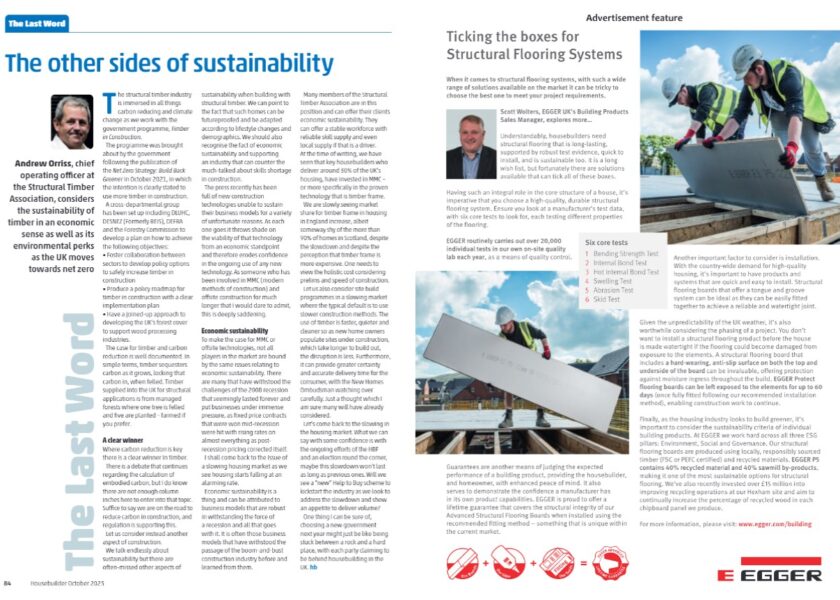Andrew Orriss has the “Last Word” In Housebuilder October issue
16/10/2023

The structural timber industry is emersed in all things carbon reducing and climate change as we work with the Government programme “Timber in Construction”.
The programme was brought about by the Government following the publication of the Net Zero Strategy, Build Back Greener October 2021 whereby the intention is clearly stated to use more timber in construction.
A cross departmental group has been set up including DLUHC, DESNEZ (Formerly BEIS) DEFRA, and the Forestry Commission to develop a plan on how to achieve the following fundamental objectives:
- Foster collaboration between sectors to develop policy options to safely increase timber in construction.
- Produce a policy roadmap for timber in construction with a clear implementation plan.
- Joined-up approach to developing the UK’s forest cover to support wood processing industries.
The case for timber and carbon reduction is well documented and in simple terms timber sequesters carbon as it grows, locking that carbon in, when felled. Timber supplied into the UK for structural applications is from managed forests where 1 tree is felled and 5 are planted, farmed if you prefer.
Where carbon reduction is a key driver there is a clear winner in timber.
There is a debate that continues regarding the calculation of embodied carbon, but I do know there are not enough column inches here to enter into that topic. Suffice to say we are on the road to reduce carbon in construction, and regulation is supporting this.
Let us consider instead another aspect of construction.
We talk endlessly about sustainability but there are often-missed other aspects of sustainability when building with structural timber. We can point to the fact that such homes can be future-proofed, that can be adapted according to lifestyle changes and demographics. We should also recognise the fact of economic sustainability and supporting an industry that can counter the much talked about skills shortage in construction.
The press recently has been full of new construction technologies unable to sustain their business models for a variety of unfortunate reasons. As each one goes it throws shade on the viability of that technology from an economic standpoint and therefore erodes confidence in the ongoing use of any new technology. As someone who has been involved in MMC and Offsite construction for much longer that I would dare to admit, this is deeply saddening.
To make the case for MMC or Offsite technologies not all players in the market are bound by the same issues relating to economic sustainability. There are many that have withstood the challenges of the 2008 recession that seemingly lasted for ever and put businesses under immense pressure, as fixed price contracts that were won mid recession were hit with rising rates on almost everything as post-recession pricing corrected itself.
I shall come back to the issue of a slowing housing market as we see housing starts falling at an alarming rate.
So economic sustainability is a thing and can be attributed to business models that are robust in withstanding the force of a recession and all that goes with it. It is often those business models that have withstood the passage of the boom-and-bust construction industry before and learned from them.
Many members of the Structural Timber Association are in this position and can offer their clients economic sustainability. They can offer a stable workforce with reliable skill supply and even local supply if that is a driver. At the time of writing, we have seen that key housebuilders who deliver circa 30% of the UK’s housing, have invested in MMC – or more specifically in the proven technology that is, timber frame.
We are slowly seeing market share for timber frame in housing in England increase, albeit someway shy of the over 90% of homes in Scotland, despite the slowdown and despite the perception that timber frame is more expensive. Fair to say one needs to view the holistic cost considering prelims and speed of construction.
Let us also consider site build programmes in a slowing market where the typical default is to use slower construction methods. The use of timber is faster, quieter and cleaner so as new homeowners populate sites under construction, which take longer to build out, the disruption is less. Furthermore, it can provide greater certainty and accurate delivery time for the consumer, with the New Homes Ombudsman watching over carefully. Just a thought which I am sure many will have already considered.
Let’s come back to the slowing in the housing market. What we can say with some confidence is with the ongoing efforts of the HBF and an election round the corner maybe this slow down won’t last as long as previous ones. Will we see a “new” Help to Buy scheme to kick-start the industry as we look to address the slowdown and show an appetite to deliver volume?
One thing I can be sure of, choosing a new Government next year might just be like being stuck between a rock and a hard place, with each party claiming to be behind housebuilding in the UK.
To read full article click here